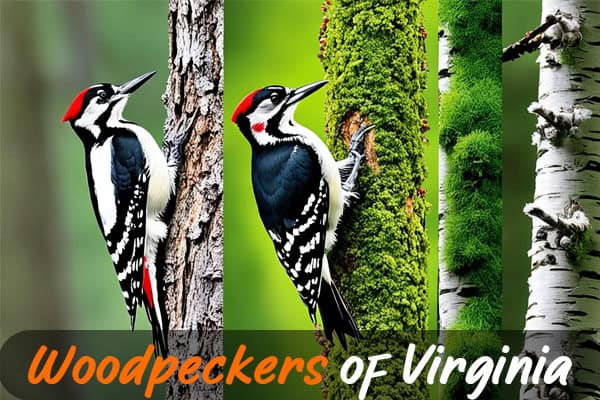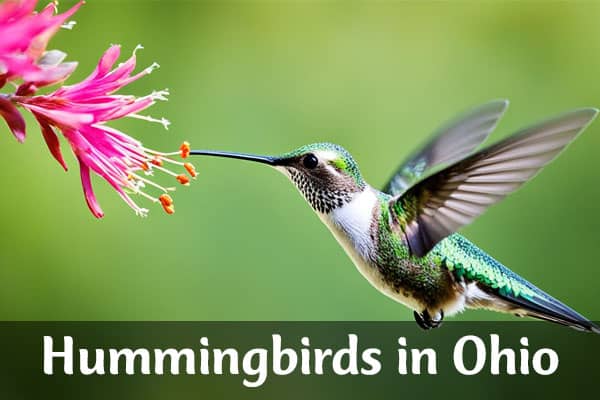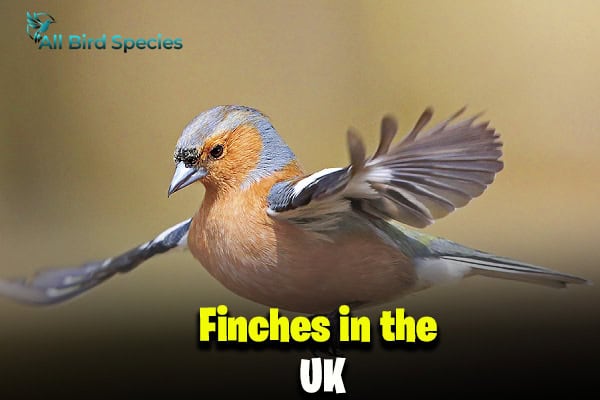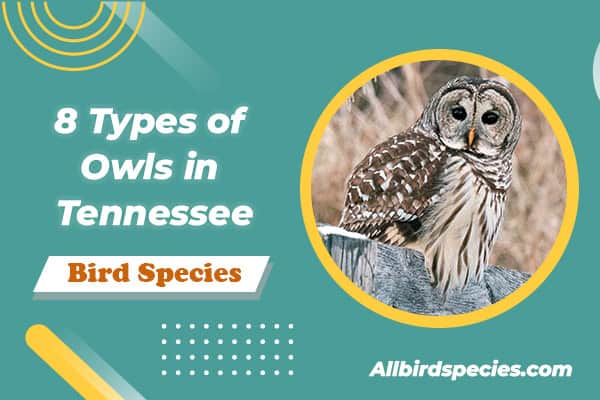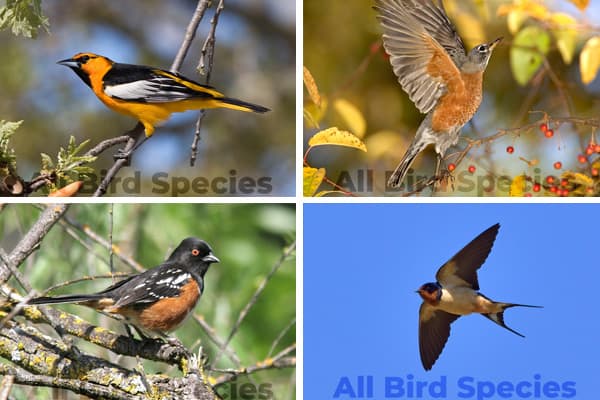8 Types Of Woodpeckers in Virginia (Incl. Stunning Photos)
Virginia is a haven for bird lovers, filled with different types of woodpeckers to discover. You can find everything from the bright Red-Headed Woodpecker to the rare Red-Cockaded Woodpecker. Each species has its own special traits and ways of living.
This guide covers the eight unique woodpecker species found in Virginia. Each bird has its own look, likes, and habits. Whether you love birdwatching or just enjoy nature, you’ll learn more about Virginia’s woodpeckers here.
1. Red-Headed Woodpecker
The red-headed woodpecker (Melanerpes erythrocephalus) stands out with its bright red head and neck. It has a black body and wings, white underparts, and a white tail patch. This bird is common in Virginia, feeding on insects, nuts, and fruits.
This woodpecker is known for its amazing flying skills, often foraging upside down. Despite being listed as “Least Concern” by the IUCN, its numbers have dropped a lot over the years. Habitat loss and removing dead trees for nests are big reasons. To help, we can make nest cavities and bird feeders. Saving dead trees and creating new nests is key to keeping these birds in Virginia.
| Habitat | Feeding Habits | Nesting Behavior |
|---|---|---|
| Pine savannahs, open forests with clear understories, pine plantations, treerows in agricultural areas, and standing timber in wetlands | Insects, nuts, fruits, and catching prey in flight | Drill a gourd-shaped cavity in snags, taking 12-17 days to complete |
The red-headed woodpecker is one of just four North American woodpeckers that stores food. They cover their food with wood or bark. Fossils of this species have been found in Virginia, dating back over 2 million years. But, their homes in Virginia are being lost to development, which is hurting their numbers.

“The Red-headed Woodpecker is one of the five bird species breeding in northern Virginia identified as being at a tipping point by the State of the Birds report.”
To help the red-headed woodpecker in Virginia, we must protect places like Huntley Meadows Park, Bull Run Regional Park, and Conway Robinson State Forest. These areas offer the right habitat for these birds. By making nest cavities, keeping dead trees, and other conservation efforts, we can help the red-headed woodpecker thrive in the Commonwealth.
2. Red-Bellied Woodpecker
The red-bellied woodpecker (Melanerpes carolinus) is a common bird in Virginia’s woodlands and suburbs. It’s known for its red head, neck, and underparts. These features make it stand out among woodpecker species in Virginia.
It also has a black back, wings, and tail. Plus, there’s a large white patch at the tail’s base and a white bar on its wings. These details help tell it apart from other Virginia woodpeckers.

The red-bellied woodpecker has a strong beak. It uses this to find food on tree trunks, branches, and leaves. It eats insects like ants and bees, as well as nuts and fruits.
These woodpeckers are omnivorous, meaning they eat both plants and animals. They live in mature forests and feed on a variety of foods.
These birds are also very protective of their territory. They fight off other woodpeckers, birds, and predators to protect their nests. They make their nests in tree cavities, showing how adaptable they are.
The red-bellied woodpecker is a common bird in Virginia. It’s important to recognize its unique traits and behaviors. Its striking look and adaptability make it a key part of Virginia’s bird life.
3. Pileated Woodpecker
In Virginia, the Pileated Woodpecker (Dryocopus pileatus) is a standout among woodpeckers. It’s the largest in the state, known for its black and white look, bright red crest, and big size.
This bird is big, weighing 8.8 to 12.3 ounces and being 16 to 19 inches long. It has a strong beak and can dig big holes in trees. These holes are homes, safe spots, and places to store food for many animals.
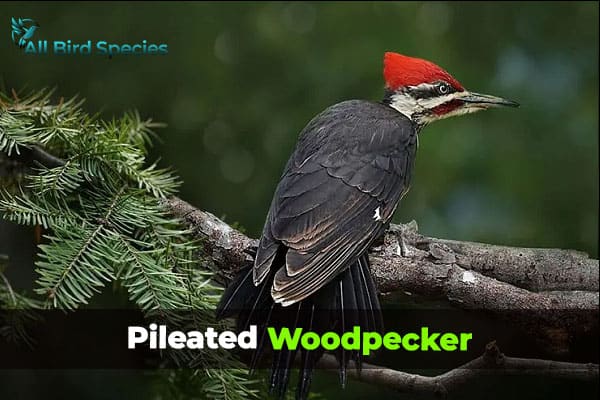
Its loud calls fill the Virginia forests. The bird drums on trees to talk to others and mark its territory. This drumming is a unique sound that travels far.
These birds live in old forests and eat many insects, like beetles and ants. They also eat fruits and nuts when they can.
They mate for life and build nests high up in trees. The nests have 3-5 eggs that take 15-18 days to hatch. The baby birds leave the nest after 24-31 days.
Seeing a Pileated Woodpecker in Virginia shows how important it is to keep forests healthy. This bird is a symbol of the beauty and variety of Virginia’s woods.
4. Downy Woodpecker
The downy woodpecker (Picoides pubescens) is a small, charming bird found in Virginia and North America. It’s one of the smallest woodpeckers, often seen in backyards and woods. Birdwatchers and nature lovers find it captivating.
This bird stands out with its black and white feathers. Its beak is small and chisel-like, and it has a unique head pattern and a white wing patch. Downy woodpeckers are important because they help control insect populations and spread tree seeds.

They eat insects like beetles and ants, finding them by pecking at tree bark. They also eat fruits, nuts, and sap by making small holes in trees.
Downy woodpeckers of Virginia are interesting to watch because of their nesting habits. Both parents work together to make their nests in trees. The female lays up to eight eggs, and both parents take turns incubating them for 12 days. After 18 days, the young birds leave the nest to start their lives.
Even though their numbers are dropping in some areas due to habitat loss, the downy woodpecker is still considered “Least Concern” by conservation groups. They are adaptable and can live in many places, from forests to backyards in Virginia.
| Characteristic | Downy Woodpecker |
|---|---|
| Body Length | 5 to 6.5 inches |
| Body Weight | Less than 1 ounce |
| Diet | Insects, fruits, nuts, sap |
| Nest Cavity Depth | 6-12 inches |
| Clutch Size | 3-8 eggs, average of 4-5 |
| Incubation Period | 12 days |
| Time to Fledge | 18 days |
| Population Estimate | Approximately 14 million in North America |
The downy woodpecker is a delightful and resilient bird, loved by birdwatchers and nature lovers in Virginia. It plays a key role in the ecosystem, showing us its unique ways and importance in nature.
5. Hairy Woodpecker
The hairy woodpecker (Picoides villosus) is a common sight in Virginia’s forests. It’s known for its black and white feathers. Bird lovers in the state enjoy seeing it at their feeders.

The hairy woodpecker stands out with its big, chisel-like bill and black and white feathers. Adults are 7.1 to 10.2 inches long and weigh 1.4 to 3.4 ounces. They are among the bigger woodpecker species in Virginia. Their long bills and strong feet help them find insects in trees.
Hairy woodpeckers live in Virginia all year. They make a lot of noise by drumming on trees. This helps them mark their territory and find a mate. Their sounds, like a “peek” or “whinny,” fill the Virginia woodlands.
There are about 9 million hairy woodpeckers worldwide. They’re not considered endangered. So, they’re a common and loved bird in Virginia.
“The hairy woodpecker is a true marvel of nature, with its striking appearance and fascinating behaviors. Observing these birds in Virginia’s forests is always a delight.”
6. Northern Flicker
The Northern Flicker, known as Colaptes auratus, is a standout woodpecker in Virginia and North America. It’s big and gray with a tan coat. You’ll notice its bold white rump when it flies. This woodpecker’s look is special, making it stand out among Virginia’s birds.
Male Northern Flickers have a small red spot on their neck. They also have a black “mustache” mark. Their bright yellow underwings are another eye-catching feature. These colors make the Northern Flicker known as the “Yellow-shafted Flickers.”

These birds live in places with trees and open areas, like parks and golf courses. You might see them flying or eating on the ground. They love to eat ants and other bugs. Their sounds, like a loud laugh and a “wicka-wicka,” make them easy to spot in Virginia.
Unlike many woodpeckers, the Northern Flicker moves south for the winter. This helps them find food and stay warm during the cold months.
| Characteristic | Description |
|---|---|
| Plumage | Gray and tan with bold white rump, buff underparts with black spotting, and black barring on back and wings |
| Male Markings | Small red spot on nape, black “mustache” mark |
| Subspecies | Yellow-shafted Flicker with bright yellow underwings |
| Habitat | Semi-open areas like parks, golf courses, and other mixed environments |
| Feeding | Primarily ants and other insects, rarely visit bird feeders |
| Migratory Behavior | Northernmost individuals migrate southward for the winter |
The Northern Flicker’s unique look and behaviors make it a fascinating bird in Virginia. Seeing one in flight or on the ground is always a treat. These birds show the beauty of Virginia’s bird life.
Woodpeckers Found In Other Different Regions
| Woodpeckers in Florida |
| Woodpeckers In Tennessee |
| Woodpeckers in Washington |
| Woodpeckers in Illinois |
| Woodpeckers in Georgia |
7. Red-cockaded woodpecker
In the old-growth pine forests of Virginia, a special bird lives – the red-cockaded woodpecker (Dryobates borealis). This small bird is a symbol of the southeastern United States. But, its numbers are getting smaller because of lost and broken habitats. This makes it a species that needs help right away.

This woodpecker stands out with its black-and-white look. It has a unique face with a black cap and a stripe under its cap. The name comes from a tiny red stripe on the male’s head. These woodpeckers of Virginia live in old pine forests, eating insects under the tree bark.
These birds face big threats from deforestation and city growth. The IUCN says they are “Threatened.” This means we must act fast to save this bird.
To help the red-cockaded woodpecker, we’re protecting its home and making special nests. Groups like the U.S. Fish and Wildlife Service and state wildlife agencies are working hard. They want to make sure this woodpecker can still be around.
“The red-cockaded woodpecker is a living fossil, a remnant of the ancient forests that once covered the southeastern United States. Its survival is a testament to the resilience of nature, and a challenge for us to preserve the delicate balance of our ecosystems.”
We’re trying to save the red-cockaded woodpecker and its home. This shows how fragile our nature is and how we must work together to save endangered species. By supporting these efforts, we can make sure this unique bird stays in Virginia’s forests for the future.
8. Red-Headed Woodpecker
The red-headed woodpecker (Melanerpes erythrocephalus) is a bird species found in Virginia and the Eastern U.S. It’s known for its bright red head, white belly, black back, and white marks on its wings. Young birds have a dark head but look similar to adults.

These woodpeckers live in the Eastern U.S. and can be seen all year. They like different kinds of places, from forests to areas with few trees, like places that have burned. They are very active and often catch insects in the air.
Red-headed woodpeckers of Virginia eat many things, like insects, fruits, nuts, seeds, and sometimes even other birds’ eggs or babies. Their ability to find and eat a wide variety of foods makes them interesting birds in Virginia.
“The red-headed woodpecker is one of the most striking and recognizable birds in North America. Its bold plumage and energetic personality make it a delight to observe in the wild.”
The number of red-headed woodpeckers has been going down for over a hundred years. This might be because of the European starling, which was brought over in the late 1800s. People are working to help these birds, so we can still see them in Virginia for a long time.
Check Our Previous Articles
| Hummingbirds in Ohio |
| Easter Egger Rooster Vs Hen: Key Differences |
| White Birds with Long Beaks |
| Two Birds on a Wire Meaning |
| Do Cardinals Mate for Life? |
9. Yellow-Bellied Sapsucker

The yellow-bellied sapsucker, known as Sphyrapicus varius, is a unique bird in Virginia. It looks quite stylish with black wings and white faces. It also has a big white mark on each wing and black and white on its back. The bird stands out with its pale yellow chest and red crown. Males have a red throat patch that sets them apart from females.
These birds migrate to Virginia in the winter. They live in different types of woods and have an interesting way of finding food. They drill holes in trees to drink sap and catch insects. This behavior makes them different from other woodpeckers in Virginia.
Keep an eye out for the yellow-bellied sapsucker in Virginia’s forests or your backyard trees. Its unique look and feeding habits make it a joy to watch. It’s a special part of Virginia’s woodpecker world.

